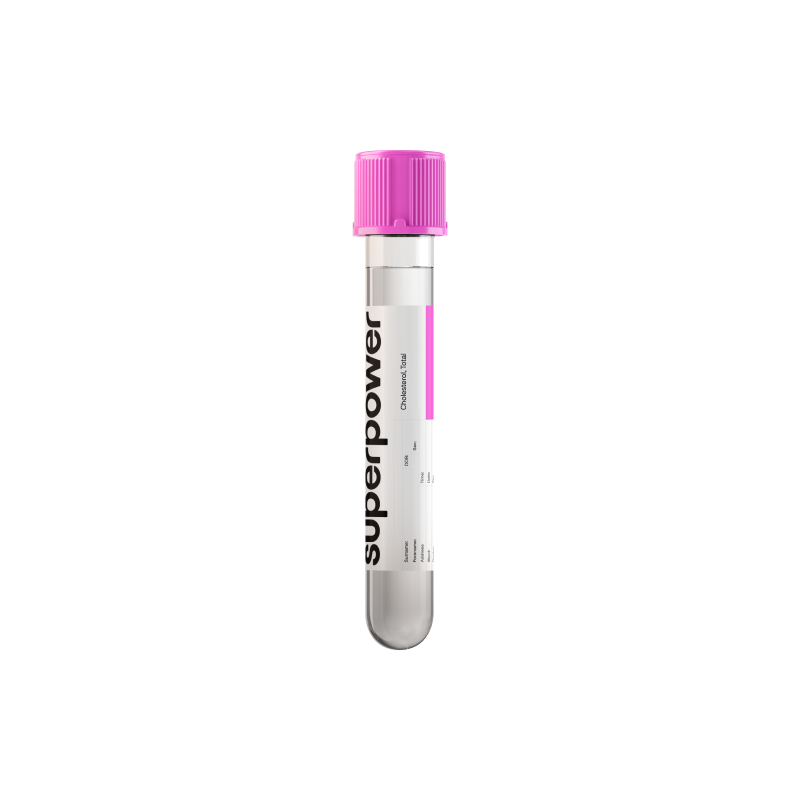Get simple, actionable insights into cardiovascular health.
Total cholesterol offers an early snapshot of heart risk, guiding when deeper lipid testing is needed and helping you track progress from lifestyle or therapy changes.
Key Benefits
- See your overall cholesterol level to gauge heart and blood vessel risk.
- Spot early cardiovascular risk that benefits from diet, exercise, or medication changes.
- Flag very high levels that suggest familial hypercholesterolemia needing specialist management.
- Guide treatment decisions by establishing a baseline and monitoring response over time.
- Explain physical findings like xanthomas or corneal arcus linked to high cholesterol.
- Clarify related conditions such as thyroid, kidney, or liver disorders affecting cholesterol levels.
- Support pregnancy planning by identifying severe dyslipidemia before conception and avoiding harmful medications.
- Best interpreted with a full lipid panel, non-HDL cholesterol, and overall risk factors.
What is Cholesterol, Total?
Total cholesterol is the sum of all cholesterol circulating in your blood, regardless of which particles carry it. Cholesterol is a waxy, fat-like sterol your body makes mainly in the liver and intestines (endogenous synthesis), with a smaller amount absorbed from food (dietary intake). Because it doesn’t dissolve in water, cholesterol travels packaged inside protein–fat carriers called lipoproteins—primarily LDL, HDL, and VLDL and their remnants. A total cholesterol result adds up the cholesterol contained within all these lipoproteins.
Cholesterol is essential building material for cell membranes and a starting molecule for steroid hormones, bile acids, and vitamin D (membrane sterol; precursor of corticosteroids, sex steroids, bile salts, cholecalciferol). The total cholesterol number reflects the overall pool being transported for delivery to tissues and return to the liver (forward delivery by apoB-containing particles; reverse transport via HDL). It captures, in one figure, the balance of production, absorption, and clearance at a given time, but it does not show how that cholesterol is distributed among particle types. Think of it as a broad snapshot of your body’s cholesterol transport system rather than a detailed map.
Why is Cholesterol, Total important?
Total cholesterol is the sum of cholesterol carried on LDL, HDL, and other lipoproteins—your body’s transport system for a vital building block. Cholesterol is essential for cell membranes, steroid hormones, vitamin D, and bile acids; yet when carried in excess on atherogenic particles, it accumulates in artery walls and drives atherosclerosis. Most labs consider values below about 200 desirable; “healthiest” tends to sit toward the lower end, but not extremely low.
When total cholesterol is low, it often reflects reduced lipoprotein production or poor absorption. This can occur with hyperthyroidism, chronic illness, malnutrition or malabsorption, liver disease, or rare genetic conditions. People may notice fatigue, weight loss, diarrhea, easy bruising, or signs of fat‑soluble vitamin deficiency; very low levels can be associated with reduced steroid hormone precursors. In children, persistently low values can signal genetic disorders or undernutrition. During pregnancy, unusually low levels may accompany inadequate nutrient intake.
When total cholesterol is high, it usually means more apoB‑containing particles are circulating, increasing the chance they enter artery walls and inflame plaques—affecting heart, brain, kidneys, and limbs. Most people feel no symptoms; at very high levels (often genetic), tendon xanthomas and early artery disease can appear. Men carry higher risk at a given level than premenopausal women; levels rise with age and after menopause. Pregnancy naturally raises total cholesterol to support fetal development. In children and teens, high values may indicate inherited lipid disorders that track into adulthood.
Big picture: total cholesterol is a useful screening lens on lipid transport, liver and thyroid function, genetics, and cardiometabolic risk. It connects to LDL/non‑HDL cholesterol, triglycerides, and apoB, and helps forecast long‑term risks like heart attack and stroke.
What Insights Will I Get?
Total cholesterol sums the cholesterol carried in all lipoproteins (LDL, HDL, VLDL/IDL). It reflects how the body builds cell membranes and makes steroid hormones, bile acids, and vitamin D, while also indicating the overall burden of atherogenic particles that influence cardiovascular risk. Because cholesterol supports myelin and synapses, it also links to cognition, and it underpins reproductive and immune signaling.
Low values usually reflect reduced production or increased clearance of lipoproteins. This occurs with too much thyroid hormone (hyperthyroidism), chronic illness or inflammation, liver disease, malabsorption/malnutrition, or rare genetic low–apoB states. System-level effects can include limited steroid hormone synthesis, reduced bile acid–mediated fat absorption, and, if very low, suboptimal transport of fat-soluble vitamins. In pregnancy or childhood, unusually low levels may signal inadequate lipid supply for growth.
Being in range suggests balanced lipoprotein transport: enough substrate for membranes and hormones without excessive atherogenic load. For cardiovascular risk, consensus tends to favor the lower end of the adult reference interval, but interpretation depends on how much is carried by LDL versus HDL.
High values usually reflect increased apoB-containing particles (LDL and remnants) from decreased LDL receptor activity, too little thyroid hormone (hypothyroidism), insulin resistance, nephrotic syndrome, cholestasis, or genetic hypercholesterolemia; HDL can contribute but is less often the driver. Levels rise with age and after menopause, and physiologic increases occur in pregnancy.
Notes: Total cholesterol is little affected by fasting. Acute illness can lower it transiently. Estrogens, retinoids, steroids, thiazides, and some antiretrovirals alter levels. Assays vary slightly. Total alone cannot distinguish LDL from HDL; context with HDL, triglycerides, non-HDL cholesterol, or apoB refines risk.



.svg)



.png)
.png)
.png)
.png)








